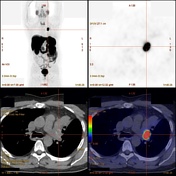Gallium-68 DOTATATE
Updates to Article Attributes
Gallium-68 DOTATATE (or Ga-68 DOTATATE) is a PET radiotracer that is useful for evaluating primary and metastatic well-differentiated neuroendocrine tumours. It is a form of somatostatin-receptor (SSTR) functional imaging and most often combined with cross-sectional imaging in the form of PET-CT.
Terminology
Gallium-68 DOTATATE is synthesised from three main components:
- gallium (Ga) radiotracer
- linked, via a chemical macrocyclic chelator, known as DOTA (or tetraxetan; IUPAC name: 1,4,7,10-tetraazacyclododecane-tetraacetic acid)
- to the short-chain peptide Tyr3-octreotate (TATE)
Pathology
Ga-68 DOTATATE has shown improved accuracy for detection relative to indium-111 pentetreotide SPECT-CT 1. It binds SSTR subtype 2 and binds 100 times more avidly than indium-111 pentetreotide 2.
There are other forms:
- DOTATOC: DOTA-d-Phe1-Tyr3-octreotide
- DOTANOC: DOTA-1-Nal3-octreotide
These have an affinity for different somatostatin receptors, SSTR subtypes 3 and 5 and SSTR subtype 5, respectively 3.
Radiographic features
There is normal Ga-68 DOTATATE uptake in the pituitary gland, spleen, liver, adrenal glands, and urinary tract 4,5.
The salivary glands and thyroid show faint to mild homogeneous uptake 4,5.
-<p><strong>Gallium-68 DOTATATE<strong></strong></strong> (or <strong>Ga-68 DOTATATE</strong>) is a <a href="/articles/pet-radiotracers">PET radiotracer</a> that is useful for evaluating primary and metastatic well-differentiated <a href="/articles/neuroendocrine-tumours">neuroendocrine tumours</a>. It is a form of <a href="/articles/somatostatin-receptor-sstr-functional-imaging">somatostatin-receptor (SSTR) functional imaging</a> and most often combined with <a href="/articles/cross-sectional-imaging-1">cross-sectional imaging</a> in the form of PET-CT.</p><h4>Terminology</h4><p>Gallium-68 DOTATATE is synthesised from three main components:</p><ol>-<li>gallium (Ga) radiotracer</li>-<li>linked, via a chemical macrocyclic chelator, known as DOTA (or tetraxetan; <a href="/articles/international-union-of-pure-and-applied-chemistry">IUPAC</a> name: 1,4,7,10-tetraazacyclododecane-tetraacetic acid)</li>-<li>to the short-chain peptide Tyr3-octreotate (TATE)</li>-</ol><h4>Pathology</h4><p>Ga-68 DOTATATE has shown improved accuracy for detection relative to <a title="Octreotide scintigraphy" href="/articles/octreotide-scintigraphy">indium-111 pentetreotide</a> <a href="/articles/single-photon-emission-computed-tomography-spect">SPECT-CT</a> <sup>1</sup>. It binds SSTR subtype 2 and binds 100 times more avidly than indium-111 pentetreotide <sup>2</sup>.</p><p>There are other forms:</p><ul>-<li>DOTATOC: DOTA-d-Phe1-Tyr3-octreotide</li>-<li>DOTANOC: DOTA-1-Nal3-octreotide</li>- +<p><strong>Gallium-68 DOTATATE<strong></strong></strong> (or <strong>Ga-68 DOTATATE</strong>) is a <a href="/articles/pet-radiotracers">PET radiotracer</a> that is useful for evaluating primary and metastatic well-differentiated <a href="/articles/neuroendocrine-tumours">neuroendocrine tumours</a>. It is a form of <a href="/articles/somatostatin-receptor-sstr-functional-imaging">somatostatin-receptor (SSTR) functional imaging</a> and most often combined with <a href="/articles/cross-sectional-imaging-1">cross-sectional imaging</a> in the form of PET-CT.</p><h4>Terminology</h4><p>Gallium-68 DOTATATE is synthesised from three main components:</p><ol>
- +<li>gallium (Ga) radiotracer</li>
- +<li>linked, via a chemical macrocyclic chelator, known as DOTA (or tetraxetan; <a href="/articles/international-union-of-pure-and-applied-chemistry">IUPAC</a> name: 1,4,7,10-tetraazacyclododecane-tetraacetic acid)</li>
- +<li>to the short-chain peptide Tyr3-octreotate (TATE)</li>
- +</ol><h4>Pathology</h4><p>Ga-68 DOTATATE has shown improved accuracy for detection relative to <a title="Octreotide scintigraphy" href="/articles/octreotide-scintigraphy">indium-111 pentetreotide</a> <a href="/articles/single-photon-emission-computed-tomography-spect">SPECT-CT</a> <sup>1</sup>. It binds SSTR subtype 2 and binds 100 times more avidly than indium-111 pentetreotide <sup>2</sup>.</p><p>There are other forms:</p><ul>
- +<li>DOTATOC: DOTA-d-Phe1-Tyr3-octreotide</li>
- +<li>DOTANOC: DOTA-1-Nal3-octreotide</li>
Image 1 ( update )

Image 3 Nuclear medicine (68Ga-DOTATATE PET/CT) ( create )








 Unable to process the form. Check for errors and try again.
Unable to process the form. Check for errors and try again.